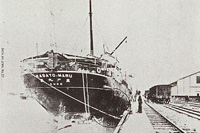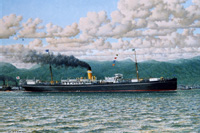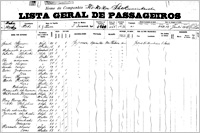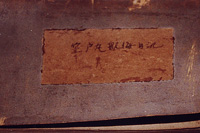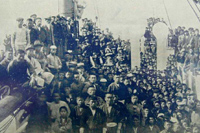Ship Kasato-maru
"Kasato-maru" is not just the name of a ship. For the Japanese people who have emigrated to Brazil for sixty years and their descendants, the ship "Kasato-maru"also symbolizes a zero milestone of the eternal history of people of Japanese descent in Brazil.’ ("Sixty years since the Kasato-maru", League of Prefecture Societies in Brazil. 1969 p. 13)
The ship Kasato-maru (Oriental Steamship Company; Gross tonnage: 6,167 tons), raised its anchor and set sail direct for Santos, carrying the first set of 781 contracted emigrants, lit up with fireworks celebrating the ship’s departure. The emigrants sailed aboard the ship Kasato-maru nearly 12,000 nautical miles for 50 days, suffering from seasickness and the heat, while recreating theselves with meals and entertainment, and arrived at the 14th wharf, Port Santos on June 18. In Brazil this day is remembered as the "day of Japanese immigration ", and in Japan it is "the day of overseas emigration".
Looking up at a winter waterfall,
Just arrive
on the emigrant ship.
This haiku, by Uetsuka Shuhei (haiku poetry pen name, Hyokotsu), general supervisor of the emigrants, is said to be the first haiku ever composed in Brazil. Uetsuka is known, together with the Mizuno Ryo, director of the Kokoku Shokumin Kaisha (Imperial Colonization Company), as "the Father of Emigration". "The Kasato-maru Kokai Nikki (Kasato-maru daily voyage log)" left by Mizuno is a valuable record of the ship Kasato-maru's voyage, and "the Kobe Collection" in the custody of the Kobe Maritime Meterological Observatory contains observation data showing the trail of the ship.
There are several different views about the history of the ship Kasato-maru, summarized as follows. The "Potosi", a cargo-passenger ship built in June 1900 in England was sold to the Association of the Russian Volunteer Fleet and renamed the "Kazan". After sunk by the Japanese Navy’s attack during the Russo-Japanese War at Port Arthur, it was seized by the Japanese Navy, placed under the Kure Navy District and renamed the "Kasato-maru". In July 1906 after the end of the Russo-Japanese War, the Oriental Steamship Company borrowed the ship Kasato-maru from the Navy and used it for a service between the Far East and the west coast of South America. It has gone down in history as the ship which carried the first set of emigrants to Brazil in 1908.
Mizuno’s emigration business came to a standstill with shpping the 1st set, although there are a record that the ship dropped 10 free emigrants in Rio de Janeiro, a majestic figure of the emigrant ship Kasato-maru has never been seen in the Port of Santos again. When the so-called Japanese Exclusion Act passed in the United States Congress in 1924, the ship Kasato-maru left the Port of Kobe on June 14, carrying 320 emigrants to Hawaii, which became the ship that carried the last set of emigrants to Hawaii. The ship Kasato-maru which had a curious career as an emigrant ship, carrying the first set to Brazil and the last set to Hawaii, a passenger vessel, a hospital ship, a sardine fishing ship, a salmon fishing ship, and a crabbing ship, was ironically sunk by the Soviet Navy off the Kamchatka Peninsula on August 9, 1945, which was the date of the Soviet Union entry into World War II.
At 5:55 pm on April 28, 2008, all the ships at anchor in the Port of Kobe blew their whistles simultaneously at the time of the ship Kasato-maru's setting sail from the port. At the same time, a ship left the port carrying a "lamplight of friendship" lit on the roof of the former "National Kobe Emigrant House". A plan has been drawn up for raising the ship Kasato-maru's anchor sunk to the bottom the Sea of Okhotsk 100 years after the ship set sail from the port and for preserving it in both Kobe and Brazil. The ship Kasato-maru is undoubtedly a symbol of one hundred years of emigration to Brazil and the Japanese community in Brazil, and also a symbol of new exchanges between the two countries.
-
 The ship Kasato-maru carrying the first set of Japanese emigrants (781 migrants) to Brazil
The ship Kasato-maru carrying the first set of Japanese emigrants (781 migrants) to Brazil -
 Ship Kasato-maru
Ship Kasato-maru -
 Passenger list of the ship Kasato-maru
Passenger list of the ship Kasato-maru -
 Ryo Mizuno, "Kasato-maru Kokai Nikki (Daily voyage logs of the ship Kasato-maru)"
Ryo Mizuno, "Kasato-maru Kokai Nikki (Daily voyage logs of the ship Kasato-maru)" -
Articles in newspapers / magazines
Quick report sent by Shuhei Uetsuka about the conditions of the voyage
-
 View of the departure of emigrants to Brazil in South America on board the ship Kasato-maru
View of the departure of emigrants to Brazil in South America on board the ship Kasato-maru

